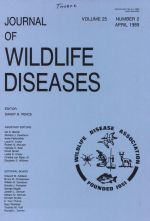In winter, pen-reared and wild black ducks (Anas rubripes), and game farm and wild mallards (Anas platyrhynchos), maintained on pelleted feed, were sham-dosed or given one number 4 lead shot. After 14 days, dosed birds were redosed with two or four additional lead shot. This dosing regimen also was repeated in summer using pen-reared black ducks and game farm mallards. Based upon mortality, overt intoxication, weight change, delta-aminolevulinic acid dehydratase activity and protoporphyrin concentration, black ducks and mallards were found to be equally tolerant to lead shot. However, captive wild ducks were more sensitive than their domesticated counterparts, as evidenced by greater mortality and weight loss following lead shot administration. This difference may be related to stress associated with captivity and unnatural diet.
How to translate text using browser tools
1 April 1989
COMPARATIVE TOXICITY OF LEAD SHOT IN BLACK DUCKS (ANAS RUBRIPES) AND MALLARDS (ANAS PLATYRHYNCHOS)
Barnett A. Rattner,
W. James Fleming,
Christine M. Bunck

Journal of Wildlife Diseases
Vol. 25 • No. 2
April 1989
Vol. 25 • No. 2
April 1989
Anas platyrhynchos
Anas rubripes
Black ducks
experimental study
lead poisoning
lead shot
mallards




